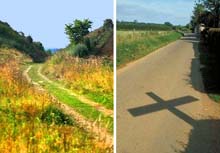Walsingham pilgrimage trail

|

|

|
a quiet walk along a disused railway line has
replaced the busy main road along the pilgrims'
final stretch into Walsingham
|
The shrine of Our Lady at Walsingham in Norfolk is the
most popular Catholic shrine in Britain, and has been a
place of pilgrimage for nearly a thousand years.
In 1061, five years before the Norman
invasion of England, an aristocratic woman called Lady
Richeld, had a vision of the Virgin, asking her to build
a replica of the Nazareth house where Mary first learned
that she would be the mother of the Messiah. Lady
Richeld did this at Walsingham, and when her son
returned home from the Crusades, he endowed the shrine.
It was considered to be the English Nazareth, and in the
Middle Ages the only site to rival it was Canterbury.
The
last pilgrim shrine before you reach Walsingham is the
Slipper Chapel at Houghton St Giles. It is a mile away
from the final destination, a place where pilgrims
traditionally removed their shoes in order to walk the
rest of the route barefoot.
But in recent
years that final mile has become a busy road – mostly
because so many visitors arrive at Walsingham by car and
coach – and the pilgrims travelling there on foot in the
traditional way do not get the quiet meditative walk
that they crave.
The Sacred Land Project has
helped advise the local community on how to move the
route onto the quiet trail of a disused railway line –
with wheelchair access and all banks sown with
wildflowers and English trees.
|

